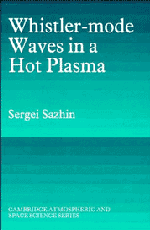Book contents
- Frontmatter
- Contents
- Acknowledgements
- Introduction
- 1 Basic equations
- 2 Propagation in a cold plasma
- 3 Parallel propagation (weakly relativistic approximation)
- 4 Parallel propagation (non-relativistic approximation)
- 5 Quasi-longitudinal approximation
- 6 Quasi-electrostatic approximation
- 7 Growth and damping of the waves
- 8 Non-linear effects
- 9 Applications to the Earth's magnetosphere
- References
- Solutions to the problems
- Index
7 - Growth and damping of the waves
Published online by Cambridge University Press: 30 October 2009
- Frontmatter
- Contents
- Acknowledgements
- Introduction
- 1 Basic equations
- 2 Propagation in a cold plasma
- 3 Parallel propagation (weakly relativistic approximation)
- 4 Parallel propagation (non-relativistic approximation)
- 5 Quasi-longitudinal approximation
- 6 Quasi-electrostatic approximation
- 7 Growth and damping of the waves
- 8 Non-linear effects
- 9 Applications to the Earth's magnetosphere
- References
- Solutions to the problems
- Index
Summary
As was shown in Section 2.1, the general solution of the wave dispersion equation in a ‘cold’ plasma (see equation (2.4)) describes either wave propagation without damping or growth (N02 0), or the absence of the waves (N02 ≤ 0; N0 = 0 corresponds to plasma cutoffs). However, wave propagation in a plasma with non-zero temperature is accompanied, in general, by a change of amplitude of the waves, Aw, which is described by the increment of growth (γ > 0) or the decrement of damping (γ < 0) (Aw ∼ {\rm exp}(γt)). When ⃒γ⃒ ≪ {\rm min} (ω0, Ω − ω0) (which is satisfied in most cases of whistlermode propagation in the magnetosphere and will hereafter be assumed to be valid) then γ is described by equation (1.17). In this chapter, the latter equation will be applied to the analysis of whistler-mode growth (γ > 0) or damping (γ < 0) in different limiting cases of wave propagation considered in Chapters 3–6.
Parallel propagation (weakly relativistic approximation)
As was shown in Section 3.1, the general dispersion equation for parallel whistler-mode propagation in a weakly relativistic plasma, with the electron distribution function (1.76) (with j = 0), can be written in the form (3.10). This equation describes both wave propagation (see equation (1.16)) and the growth or damping (see equation (1.17)). The processes of parallel whistlermode propagation in a weakly relativistic plasma in different limiting cases were analysed in Sections 3.2 and 3.3.
- Type
- Chapter
- Information
- Whistler-mode Waves in a Hot Plasma , pp. 144 - 184Publisher: Cambridge University PressPrint publication year: 1993



